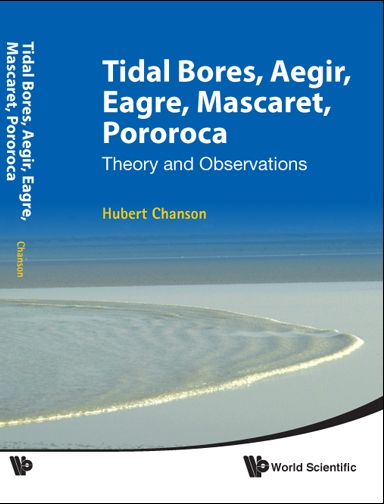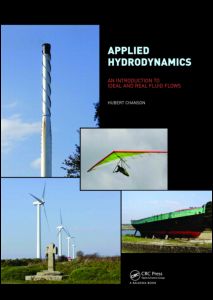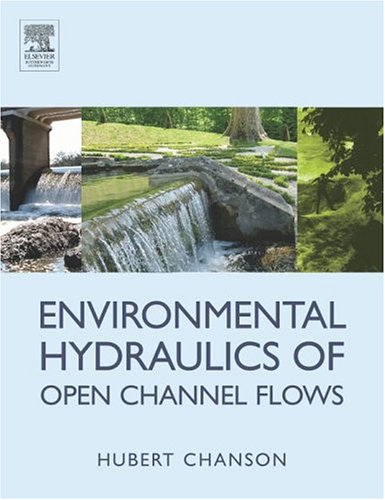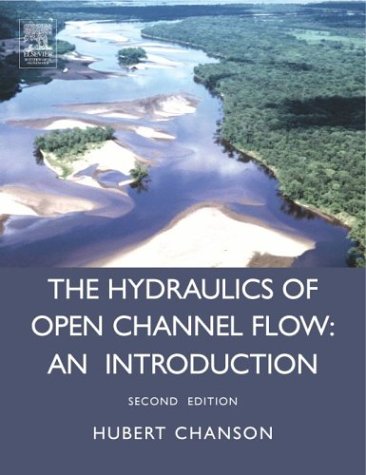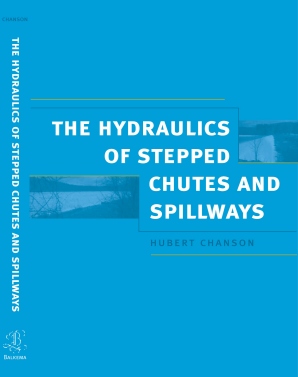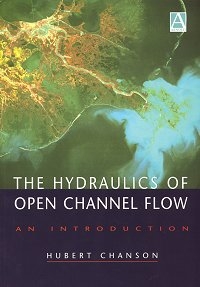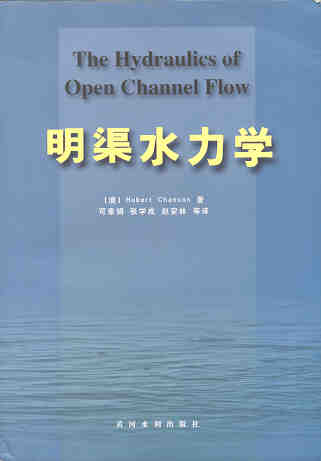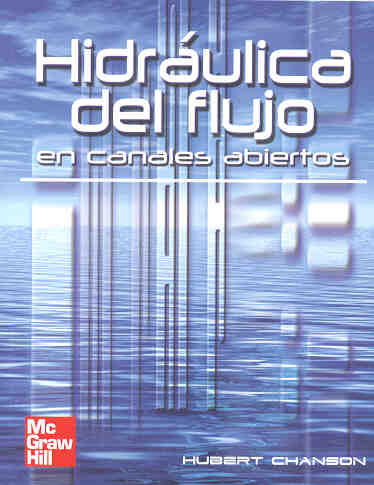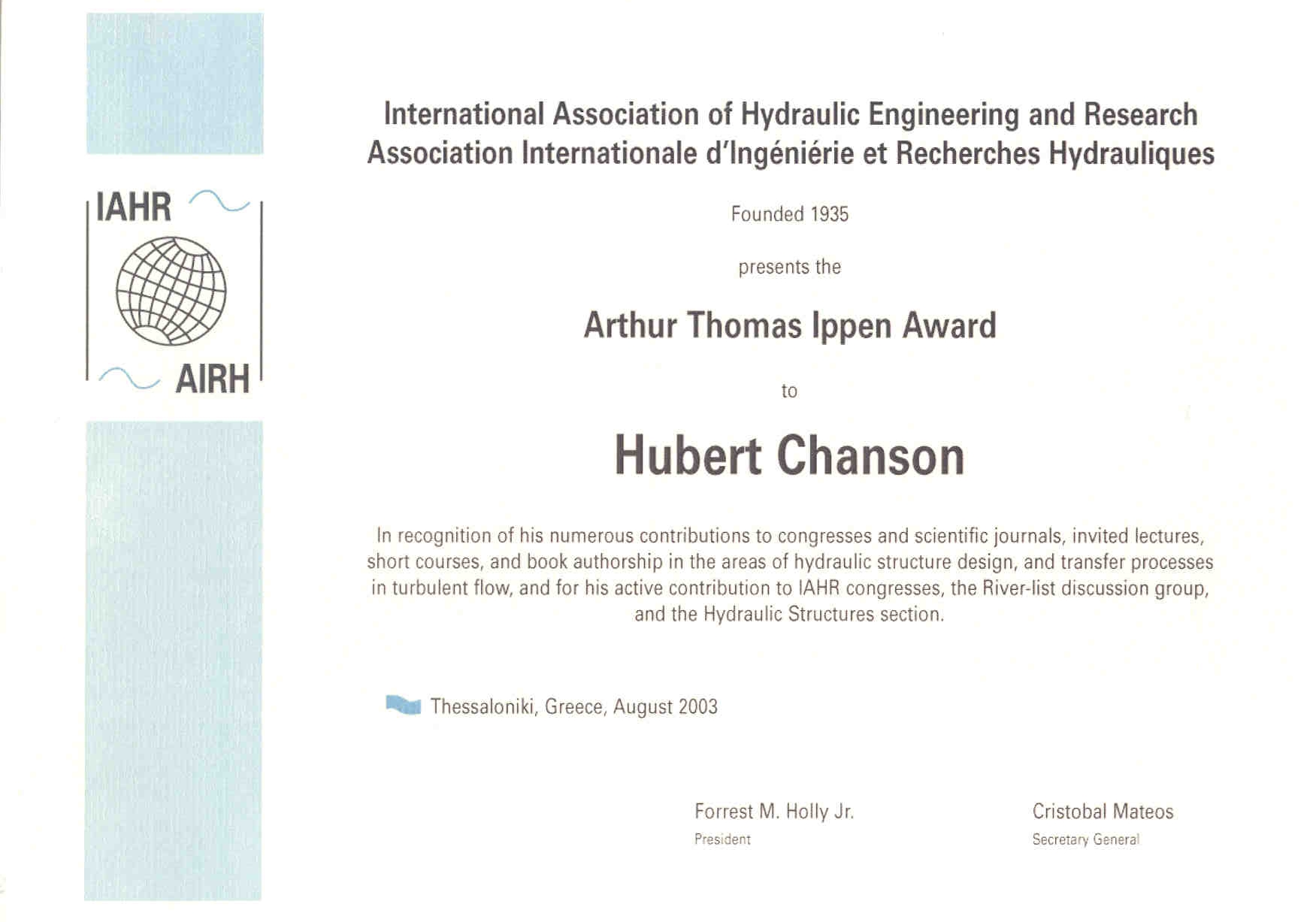AIR ENTRAINMENT AT A CIRCULAR
PLUNGING JET: PHYSICAL AND ACOUSTIC CHARACTERISTICS - Internet
Database
by Hubert CHANSON
School of Civil Engineering, The University of
Queensland, Brisbane QLD 4072, Australia
(Email: h.chanson@uq.edu.au,
Internet : http://www.uq.edu.au/~e2hchans/index.html)
and Richard MANASSEH
formerly CSIRO-DBCE, PO Box 56, Highett QLD 3190,
Australia
(Email: richard.manasseh@dbce.csiro.au,
Internet : http://fluids.mel.dbce.csiro.au/~richman/home.html)
Internet database : http://www.uq.edu.au/~e2hchans/photo.html
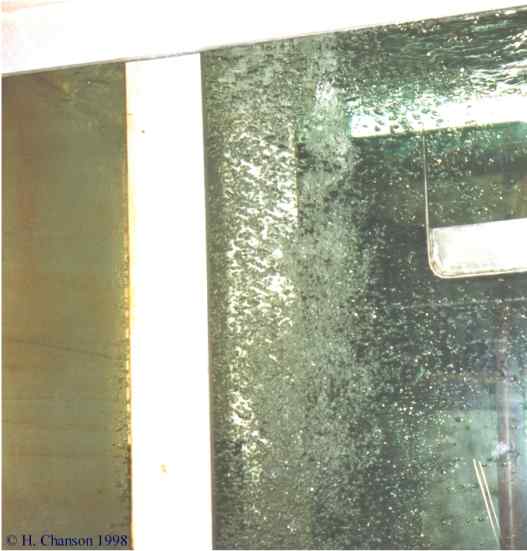
Summary
Plunging jet flows are employed to produce some
gas-liquid interface, typically to dissolve gas in liquid. They are
bottlenecks in minerals
and food processing, biotechnology and waste-water treatment. The
mechanisms
of air bubble entrainment by circular plunging jets are discussed in
the
light of new experimental evidence. The results were obtained in the
developing
flow region of 25-mm diameter water jets (see Photograph).
Void
fraction distributions follow closely an advective diffusion
theory, and the bubble count rate distribution exhibit consistently a
maximum in the
inner side of the void fraction peak. Acoustic measurements of the
bubbly
flow were further conducted with void fractions up to 40% (CHANSON
and
MANASSEH 2003).
The article is complemented by a website database for two-dimensional
plunging
jets: http://www.uq.edu.au/~e2hchans/data/jfe97.html. Further experiments were further performed to study air
entrainment
in seawater, salty freshwater and freshwater. Results were presented by
CHANSON
et al. (2002,2006).
NOTE: The attachments are JPEG and WAV formats. With
Netscape, make sure that the JPEG file format is handled by Netscape
Navigator (Edit/Preferences/Navigator/Applications) and the WAV file
format is handled by Quiktime or Media Player. After viewing the figure
or listenign to the audiofile, click on the button BACK to return to
the photograph list (i.e. this document).
Experimental apparatus
The experimental apparatus consists of a vertical
circular jet issuing from a 0.025-m diameter nozzle. The receiving
channel is 0.3-m wide and 1.8-m deep with glass walls (See Figure).
Underwater acoustics was measured with a
B&K hydrophone type 8103 connected to a B&K charge amplifier
type 2635. The signal was recorded on Digital Audio Tape (DAT) which
digitised the signal at 44.1 kHz, thereby implying an alias frequency
around 22 kHz..
Acoustic Recording
Three data sets were selected from one run (Run RM3,
see
table below). The experiments were conducted with a 5-mm free-jet
length. The hydrophone was located 20-mm below the free-surface. Each
file is a VAW
format that may be played with Media Player or Sound Recorder
applications (Windows 95 or later), or Quicktime.
At low jet velocities (V1 = 0.94 /s), a small number
of distinct high-pitch sounds are heard corresponding to the
entrainment of individual
bubbles. The high-pitch associated with high frequency sound is
characteristic
of a small bubble size. (The sound frequency is basically inversely
proportional
to the bubble size.)
In the second recording, the louder noise characterises
a
higher bubble entrainment rate. The combination of high-pitch and
louder "rumble"
indicates the entrainment of both small individual bubbles as well as
larger
air bubbles/packets.
A the largest flow velocity (V1 = 5 m/s), the bubble
noise
is louder and covers a wide range of frequencies. This is
characteristic of
a stronger air bubble entrainment rate.

References
BRATTBERG, T., and CHANSON, H. (1998). "Air Entrapment
and Air Bubble
Dispersion at Two-Dimensional Plunging Water Jets." Chemical
Engineering
Science, Vol. 53, No. 24, Dec., pp. 4113-4127 (ISSN
0009-2509) (Download PDF file) (PDF
file
at UQeSpace). Errata: 1999, Vol.
54, No. 12, p. 192 (Download PDF
file).
CHANSON, H. (1997). "Air
Bubble Entrainment in Free-Surface Turbulent Shear Flows."
Academic Press, London, UK,
401
pages (ISBN 0-12-168110-6).
CHANSON, H. (2004). "Air Entrainment in
Hydraulic
Engineering." in "Fluvial,
Environmental & Coastal Developments in Hydraulic Engineering",
Balkema,
Leiden, The Netherlands, Proc. International Workshop on
State-of-the-Art
Hydraulic Engineering, 16-19 Feb. 2004, Bari, Italy, M. MOSSA, Y.
YASUDA and H. CHANSON Ed., pp. 17-63 (ISBN 04 1535 899 X). (PDF
file
at UQeSpace)
CHANSON, H. (2009). "Turbulent Air-water Flows in Hydraulic
Structures:
Dynamic Similarity and Scale Effects." Environmental
Fluid Mechanics,
Vol. 9, No. 2, pp. 125-142 (DOI: 10.1007/s10652-008-9078-3) (ISSN
1567-7419 [Print] 1573-1510 [Online]). (PDF
file at
UQeSpace)
CHANSON, H., AOKI, S., and HOQUE, A. (2002).
"Similitude
of Air
Bubble
Entrainment and Dispersion in Vertical Circular Plunging Jet Flows. An
Experimental Study with Freshwater, Salty Freshwater and Seawater." Coastal/Ocean
Engineering
Report, No. COE02-1, Dept. of Architecture and Civil
Eng.,
Toyohashi University of Technology, Japan. (Download
PDF
files)
CHANSON, H., AOKI, S., and HOQUE, A. (2002).
"Scaling
Bubble Entrainment and Dispersion in Vertical Circular Plunging Jet
Flows: Freshwater versus Seawater." Proc. 5th Intl Conf. on
Hydrodynamics ICHD 2002., Tainan, Taiwan, H.H. HWUNG, J.F. LEE
& K.S. HWANG Editors, pp. 431-436. (Download
PDF File)
CHANSON, H., AOKI, S., and HOQUE, A. (2002). "Similitude of Air
Entrainment at Vertical Circular Plunging Jets." Proc. 2002 ASME
Joint US-European Fluids Eng. Conf., FEDSM-2002, Montréal,
Canada, Paper FEDSM2002-31024, 6 pages (CD-ROM) (ISBN 0-7918-3600-2). (download PDF
file)
CHANSON, H., AOKI, S., and HOQUE, A. (2004).
"Physical Modelling and
Similitude of Air Bubble Entrainment at Vertical Circular Plunging
Jets." Chemical Engineering Science,
Vol. 59, No. 4, pp. 747-754 (ISSN
0009-2509). (PDF
file
at UQeSpace)
(Download PDF
file)
CHANSON, H., AOKI, S., and HOQUE, A. (2006). "Bubble
Entrainment and
Dispersion in Plunging Jet Flows: Freshwater versus Seawater." Journal
of Coastal Research, Vol.
22,
No. 3, May, pp. 664-677 (DOI: 10.2112/03-0112.1) (ISSN
0749-0208). (PDF
file
at UQeSpace)
CHANSON, H., and BRATTBERG, T. (1998).
"Air Entrainment by Two-Dimensional Plunging Jets : the Impingement
Region and the Very-Near Flow Field." Proc. 1998 ASME Fluids Eng.
Conf., FEDSM'98, Washington DC, USA, June 21-25, Keynote paper,
Paper
FEDSM98-4806, 8 pages (CD-ROM) (ISBN 0 7918 1950 7). (PDF
file
at UQeSpace)
CHANSON, H., and MANASSEH, R. (2003). "Air
Entrainment Processes in a
Circular Plunging Jet. Void Fraction and Acoustic Measurements." Journal
of Fluids Engineering,
Trans. ASME,
Vol. 125, No. 5, Sept., pp. 910-921 (ISSN 0098-2202). (Download
PDF
file) (PDF
file
at UQeSpace)
CUMMINGS, P.D., and CHANSON, H. (1997). "Air
Entrainment in the Developing Flow Region of Plunging Jets. Part 1
Theoretical Development." Jl of Fluids Eng., Trans. ASME, Vol.
119, No. 3, pp. 597-602 (ISSN
0098-2202). (download PDF
file)
CUMMINGS, P.D., and CHANSON, H. (1997). "Air
Entrainment in the
Developing Flow Region of Plunging Jets. Part 1 Theoretical
Development." Journal of Fluids Engineering, Transactions ASME,
Vol. 119, No. 3,
pp. 597-602 (ISSN 0098-2202). (
download PDF
file) (PDF
file
at UQeSpace)
CUMMINGS, P.D., and CHANSON, H. (1997). "Air
Entrainment in the
Developing Flow Region of Plunging Jets. Part 2 : Experimental." Journal
of
Fluids Engineering, Transactions ASME, Vol. 119, No. 3, pp.
603-608 (ISSN
0098-2202). (download PDF file) (PDF
file
at UQeSpace) {Databank}
MANASSEH, R., and CHANSON, H. (2001). "Void-Fraction
and Acoustic
Characteristics
of Gas Bubbles Entrained by a Circular Plunging Jet." Proc. 4th
Intl
Conf. Multiphase Flow, ICMF'01, New Orléans, USA, Paper 347,
12
pages (CD-ROM). [download
PDF file]
Related bibliography
BERTOLA, N.J., WANG, H., and CHANSON, H. (2018), "Air
Bubble Entrainment, Breakup and Interplay in Vertical Plunging Jets." Journal
of Fluids Engineering, ASME, Vol. 140, No. 9, Paper 091301, 13 pages
(DOI: 10.1115/1.4039715) (ISSN 0098-2202). (PDF
file) (Preprint
at UQeSpace)
CHANSON, H. (1995). "Air Bubble Entrainment in
Free-surface Turbulent Flows. Experimental Investigations." Report
CH46/95, Dept. of Civil Engineering, University of Queensland,
Australia, June, 368 pages (ISBN 0 86776 611 5). (PDF
Version at
EprintsUQ) (Click
to
order Bound
Copy) {Databank}
CHANSON, H,. (2002). "An Experimental Study of
Roman Dropshaft
Operation : Hydraulics, Two-Phase Flow, Acoustics." Report
CH50/02,
Dept of Civil Eng., Univ. of Queensland, Brisbane, Australia,
99 pages (ISBN 1864996544). (
Download PDF
files http://www.uq.edu.au/~e2hchans/ch5002.zip [2.5 Mb])
(PDF
version at EprintsUQ) Order
Hard Copy
CHANSON, H. (2003). "Experimental Investigation of
Dropshaft
Hydraulics: Two-Phase Flow and Acoustics." Proc. 30th IAHR Biennial
Congress, Thessaloniki,
Greece, J. GANOULIS and P. PRINOS Ed., Vol. B, pp. 353-360 (ISBN
960-243-594-1). (Download PDF
File)
CHANSON, H. (2004). "Understanding Air-Water Mass
Transfer at
Rectangular Dropshafts." Journal of
Environmental Engineering and Science, NRC, Vol. 3, No. 5, pp.
319-330 (ISSN
1496-256X). (PDF
file
at UQeSpace) (Download PDF
file)
CHANSON, H. (2004). "Hydraulics of Rectangular
Dropshafts." Journal of Irrigation
and
Drainage Engineering, ASCE, Vol. 130, No. 6, pp. 523-529 (ISSN
0733-9437). (PDF
file
at UQeSpace) (Download
PDF file)
CHANSON, H. (2007). "Air Entrainment Processes in
Rectangular Dropshafts at Large Flows." Journal
of Hydraulic Research,
IAHR, Vol. 45, No. 1, pp. 42-53 (ISSN 0022-1686). (PDF
file
at UQeSpace)
CHANSON,
H. (2013). "Hydraulics of Aerated Flows: Qui Pro Quo?" Journal
of Hydraulic Research,
IAHR,
Invited Vision paper, Vol. 51, No. 3, pp. 223-243 (DOI:
10.1080/00221686.2013.795917)
(ISSN 0022-1686). (Postprint
at
UQeSpace) (PDF
file)
CHANSON, H., and BRATTBERG, T. (1997).
"Experimental
Investigations
of
Air Bubble Entrainment in Developing Shear
Layers." Report CH48/97, Dept. of Civil Engineering, University
of Queensland, Australia, Oct., 309 pages (ISBN 0 86776 748 0).
(Order a Hard Copy) (PDF
Version at
EprintsUQ)
MURZYN,
F., and CHANSON, H. (2008). "Experimental Assessment of Scale Effects
Affecting Two-Phase Flow Properties in Hydraulic Jumps." Experiments
in Fluids, Vol. 45, No.
3, pp. 513-521 (DOI: 10.1007/s00348-008-0494-4) (ISSN 0723-4864). (PDF
file
at UQeSpace)
Related Internet Links
Air
entrainment
in
the developing flow region of two-dimensional plunging jets -
Databank
{http://www.uq.edu.au/~e2hchans/data/jfe97.html}
Research
Papers
in Environmental Fluid Mechanics and Water Engineering
{http://www.uq.edu.au/~e2hchans/reprints.html}
Internet
Resources
in
Environmental Fluid Mechanics, Hydraulic Engineering and Water
Sciences
{http://www.uq.edu.au/~e2hchans/url_menu.html}
License

This work is licensed under a Creative
Commons
Attribution-NonCommercial 3.0 Unported License.
About Prof
Hubert CHANSON
Hubert
CHANSON is a Professor in Civil Engineering, Hydraulic
Engineering and Environmental Fluid Mechanics at the University
of Queensland, Australia. His research interests include design of
hydraulic structures, experimental investigations of two-phase flows,
applied hydrodynamics, hydraulic engineering, water quality modelling,
environmental fluid mechanics, estuarine processes and natural resources.
He has been an active consultant for both governmental agencies and
private organisations. His publication record includes over 850
international refereed papers and his work was cited over 3,900 times
(WoS) to 14,900 times (Google
Scholar) since 1990. His h-index is 33 (WoS), 36 (Scopus) and 60 (Google
Scholar), and he is ranked among the 150 most cited researchers in
civil engineering in Shanghai’s
Global Ranking of Academics. Hubert Chanson is the author of twenty
books, including "Hydraulic Design
of Stepped Cascades, Channels, Weirs and Spillways" (Pergamon,
1995), "Air Bubble Entrainment in
Free-Surface Turbulent Shear Flows" (Academic
Press, 1997), "The Hydraulics
of Open Channel Flow : An Introduction" (Butterworth-Heinemann,
1st edition 1999, 2nd
editon 2004), "The Hydraulics of
Stepped Chutes and Spillways" (Balkema,
2001), "Environmental
Hydraulics of Open Channel Flows" (Butterworth-Heinemann,
2004), "Tidal
Bores, Aegir, Eagre, Mascaret, Pororoca: Theory And Observations" (World
Scientific, 2011) and "Applied
Hydrodynamics:
an Introduction" (CRC
Press, 2014). He co-authored two further books "Fluid Mechanics for
Ecologists" (IPC Press, 2002) and "Fluid Mechanics for Ecologists.
Student Edition" (IPC, 2006). His
textbook "The Hydraulics of Open Channel Flows : An Introduction" has
already been translated into Spanish (McGraw-Hill
Interamericana) and Chinese (Hydrology Bureau of Yellow
River Conservancy Committee), and the second
edition was published in 2004. In 2003, the IAHR
presented him with the 13th Arthur Ippen Award
for outstanding achievements in hydraulic engineering. The American
Society of Civil Engineers, Environmental and Water Resources Institute
(ASCE-EWRI) presented him with the 2004 award for the Best Practice paper
in the Journal of Irrigation and Drainage Engineering ("Energy
Dissipation
and Air Entrainment in Stepped Storm Waterway" by Chanson and
Toombes 2002) and the 2018 Honorable Mention Paper Award for "Minimum Specific
Energy and Transcritical Flow in Unsteady Open-Channel Flow" by
Castro-Orgaz and Chanson (2016) in the ASCE Journal of Irrigation and
Drainage Engineering. Hubert Chanson edited further several books,
including the recent monograph "Energy
Dissipation
in Hydraulic Structures" (Chanson 2015, IAHR
Monograph, CRC Press). He chaired the Organisation of the 34th
IAHR World Congress held in Brisbane, Australia between 26 June and
1 July 2011. He chaired the Scientific Committee of the 5th IAHR
International Symposium on Hydraulic Structures held in Brisbane in
June 2014. He chairs the Organisation of the 22nd Australasian Fluid
Mechanics Conference in Brisbane, Australia on 6-10 December 2020.
His Internet home page is http://www.uq.edu.au/~e2hchans.
He also developed a gallery of photographs website {http://www.uq.edu.au/~e2hchans/photo.html}
that received more than 2,000 hits per month since inception.
This page was visited : 5,784 times between
January 2000 and June 2012.
Last updated on 25/06/2018



